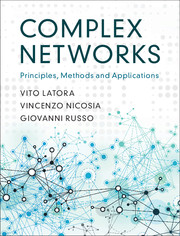Book contents
- Frontmatter
- Dedication
- Contents
- Preface
- Introduction
- Epigraph
- 1 Graphs and Graph Theory
- 2 Centrality Measures
- 3 Random Graphs
- 4 Small-World Networks
- 5 Generalised Random Graphs
- 6 Models of Growing Graphs
- 7 Degree Correlations
- 8 Cycles and Motifs
- 9 Community Structure
- 10 Weighted Networks
- Appendices
- References
- Author Index
- Index
8 - Cycles and Motifs
Published online by Cambridge University Press: 11 October 2017
- Frontmatter
- Dedication
- Contents
- Preface
- Introduction
- Epigraph
- 1 Graphs and Graph Theory
- 2 Centrality Measures
- 3 Random Graphs
- 4 Small-World Networks
- 5 Generalised Random Graphs
- 6 Models of Growing Graphs
- 7 Degree Correlations
- 8 Cycles and Motifs
- 9 Community Structure
- 10 Weighted Networks
- Appendices
- References
- Author Index
- Index
Summary
What are the building blocks of a complex network? We have seen in Chapter 4 that triangles are highly recurrent in social and biological networks, so that they can be considered as one of their elementary bricks. In this chapter we will discuss a general approach to define and detect the building blocks of a given network. The basic idea is to look not only at triangles but also at cycles of length larger than three, and at other small subgraphs, known as motifs, which occur in real networks more frequently than in their corresponding randomised counterparts. We will first derive a set of formulas to count the number of cycles in a graph directly from its adjacency matrix. As an application, we will use these formulas to find the number of cycles of different lengths in urban street networks and to compare various cities from all over the world. Notice that urban streets are a very special type of network. Their nodes have a position in Euclidean space and their links have a length, and as such they need to be described in terms of spatial graphs. The topology of spatial graphs is constrained by their spatial embedding, so that urban streets require special treatment. This will imply, in our case, the choice of appropriate spatial graphs to use as network null models when counting cycles in a city. In the second part of the chapter we will concentrate on other small subgraphs which are overabundant in some real networks and can therefore be very useful to characterise their microscopic properties. In particular, we will show that one specific motif, namely the so-called feed-forward loop, that emerges in the structure of the transcription regulation network of E. coli and of other biological networks, is there because it plays an important biological function. This relation between structure and function is the main reason why, by performing a so-called motif analysis and by looking at the profile of abundance of all possible subgraphs, it is possible to classify complex networks and to group them into different network superfamilies.
- Type
- Chapter
- Information
- Complex NetworksPrinciples, Methods and Applications, pp. 294 - 331Publisher: Cambridge University PressPrint publication year: 2017



